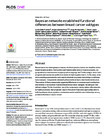Bayesian networks established functional differences between breast cancer subtypes
dc.contributor.author
Trilla-Fuertes, Lucía
dc.contributor.author
Gámez-Pozo, Angelo
dc.contributor.author
Arevalillo, Jorge M.
dc.contributor.author
López-Vacas, Rocío
dc.contributor.author
López-Camacho, Elena
dc.contributor.author
Prado-Vázquez, Guillermo
dc.contributor.author
Zapater-Moros, Andrea
dc.contributor.author
Díaz-Almirón, Mariana
dc.contributor.author
Ferrer-Gómez, María
dc.contributor.author
Navarro, Hilario
dc.contributor.author
Nanni, Paolo
dc.contributor.author
Zamora, Pilar
dc.contributor.author
Espinosa, Enrique
dc.contributor.author
Maín, Paloma
dc.contributor.author
Fresno Vara, Juan Á.
dc.date.accessioned
2020-07-09T15:43:21Z
dc.date.available
2020-07-09T05:09:11Z
dc.date.available
2020-07-09T15:43:21Z
dc.date.issued
2020
dc.identifier.issn
1932-6203
dc.identifier.other
10.1371/journal.pone.0234752
en_US
dc.identifier.uri
http://hdl.handle.net/20.500.11850/425373
dc.identifier.doi
10.3929/ethz-b-000425373
dc.description.abstract
Breast cancer is a heterogeneous disease. In clinical practice, tumors are classified as hormonal receptor positive, Her2 positive and triple negative tumors. In previous works, our group defined a new hormonal receptor positive subgroup, the TN-like subtype, which had a prognosis and a molecular profile more similar to triple negative tumors. In this study, proteomics and Bayesian networks were used to characterize protein relationships in 96 breast tumor samples. Components obtained by these methods had a clear functional structure. The analysis of these components suggested differences in processes such as mitochondrial function or extracellular matrix between breast cancer subtypes, including our new defined subtype TN-like. In addition, one of the components, mainly related with extracellular matrix processes, had prognostic value in this cohort. Functional approaches allow to build hypotheses about regulatory mechanisms and to establish new relationships among proteins in the breast cancer context.
en_US
dc.format
application/pdf
en_US
dc.language.iso
en
en_US
dc.publisher
PLOS
dc.rights.uri
http://creativecommons.org/licenses/by/4.0/
dc.title
Bayesian networks established functional differences between breast cancer subtypes
en_US
dc.type
Journal Article
dc.rights.license
Creative Commons Attribution 4.0 International
dc.date.published
2020-06-11
ethz.journal.title
PLoS ONE
ethz.journal.volume
15
en_US
ethz.journal.issue
6
en_US
ethz.journal.abbreviated
PLoS ONE
ethz.pages.start
e0234752
en_US
ethz.size
12 p.
en_US
ethz.version.deposit
publishedVersion
en_US
ethz.identifier.wos
ethz.identifier.scopus
ethz.publication.place
San Francisco, CA
ethz.publication.status
published
en_US
ethz.leitzahl
ETH Zürich::00002 - ETH Zürich::00003 - Schulleitung und Dienste::00022 - Bereich VP Forschung / Domain VP Research::02207 - Functional Genomics Center Zurich / Functional Genomics Center Zurich
ethz.leitzahl.certified
ETH Zürich::00002 - ETH Zürich::00003 - Schulleitung und Dienste::00022 - Bereich VP Forschung / Domain VP Research::02207 - Functional Genomics Center Zurich / Functional Genomics Center Zurich
ethz.date.deposited
2020-07-09T05:09:15Z
ethz.source
WOS
ethz.eth
yes
en_US
ethz.availability
Open access
en_US
ethz.rosetta.installDate
2020-07-09T15:43:32Z
ethz.rosetta.lastUpdated
2024-02-02T11:23:43Z
ethz.rosetta.versionExported
true
ethz.COinS
ctx_ver=Z39.88-2004&rft_val_fmt=info:ofi/fmt:kev:mtx:journal&rft.atitle=Bayesian%20networks%20established%20functional%20differences%20between%20breast%20cancer%20subtypes&rft.jtitle=PLoS%20ONE&rft.date=2020&rft.volume=15&rft.issue=6&rft.spage=e0234752&rft.issn=1932-6203&rft.au=Trilla-Fuertes,%20Luc%C3%ADa&G%C3%A1mez-Pozo,%20Angelo&Arevalillo,%20Jorge%20M.&L%C3%B3pez-Vacas,%20Roc%C3%ADo&L%C3%B3pez-Camacho,%20Elena&rft.genre=article&rft_id=info:doi/10.1371/journal.pone.0234752&
Dateien zu diesem Eintrag
Publikationstyp
-
Journal Article [128962]

